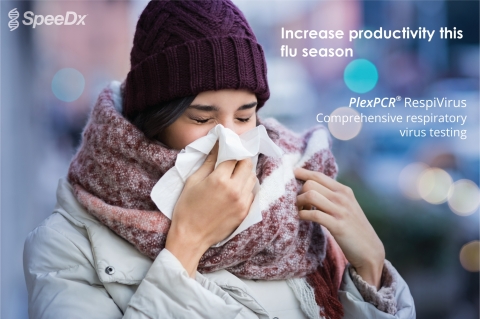SYDNEY--(BUSINESS WIRE)--SpeeDx Pty. Ltd. today announced the clearance of the PlexPCR® RespiVirus* test from the Australian Therapeutic Goods Administration (TGA). The test utilises market-leading PlexPCR® technology to detect 11 viral respiratory-illness causing pathogens and allows laboratories to process more samples in an 8-hour shift compared to standard in-house test methods. The respiratory virus test includes automated reporting software to further improve laboratory productivity and speed up result reporting processes.
“We are so pleased to be in a position to support Australian laboratories for what is already proving to be a very busy flu season,” said Colin Denver, SpeeDx CEO. “The workflow advantages afforded by PlexPCR® RespiVirus means more patient results can be reported over the course of a work day compared to standard technologies.”
Australian surveillance has recorded an unprecedented number of influenza cases in 2019 – with over four times the number of confirmed cases, compared with the first quarter year average.1 These initial numbers are well above those recorded in the early parts of 2017, where a record 233,453 cases were reported for the season.2 Laboratories were overwhelmed with the testing volumes during that time, and based on the unusual start of 2019, authorities are preparing for another potentially devastating season. The peak of the 2017 epidemic resulted in almost 30,000 hospital admissions and 745 deaths,3 now some experts are predicting up to 4,000 deaths could be possible across the 2019 season.4
The SpeeDx PlexPCR RespiVirus test detects important respiratory pathogens including Influenza A, Influenza B, Rhinovirus, Respiratory Syncytial Viruses (A & B), Human metapneumovirus, Adenovirus, and Human parainfluenza viruses 1, 2, 3 and 4. Results from the test can assist in appropriate patient care and community/outbreak management. The addition of PlexPCR RespiVirus to SpeeDx’s infectious disease test portfolio broadens the testing menu from the current suite of tests for sexually transmitted infections and antimicrobial resistance markers that include ResistancePlus® MG* and ResistancePlus® GC* – supporting Resistance Guided Therapy for Mycoplasma genitalium and gonorrhoea respectively – and PlexPCR® VHS*, a multiplex lesion diagnostic test.
| *not available in the U.S. or Europe. |
About Respiratory Viruses
Respiratory tract infections (RTIs) are responsible for the majority of primary health care consults,5 causing high morbidity and mortality, particularly in young, elderly or immune-compromised populations.6 Viral agents cause up to 90% of RTIs - mainly human rhinoviruses (RhV), influenza viruses, and respiratory syncytial virus (RSV).7 Symptoms and duration include: common cold, sinusitis, pharyngitis, epiglottitis, and laryngotracheitis.8
Bacterial infection is difficult to established without performing diagnostic tests, thus empirical use of antibiotics is discouraged in treatment guidelines.9-13 Most uncomplicated infections will clear within 2-5 days without medical intervention.14,15 However, accurate detection of respiratory viruses is important in patient care, guiding therapy and infection control measures.16 Most importantly, distinguishing bacterial RTIs from viral is essential to avoid unnecessary antibiotic prescription. Pathogen identification is also a key component in management of acute respiratory infection outbreaks and pandemic preparedness strategies.16,17
About SpeeDx
Founded in 2009, SpeeDx is an Australian-based private company with offices in London and the US, and distributors across Europe. SpeeDx specializes in molecular diagnostic solutions that go beyond simple detection to offer comprehensive information for improved patient management. Innovative real-time polymerase chain reaction (qPCR) technology has driven market-leading multiplex detection and priming strategies. Product portfolios focus on multiplex diagnostics for sexually transmitted infection (STI), antibiotic resistance markers, and respiratory disease. For more information on SpeeDx please see https://plexpcr.com
References
- http://www.health.gov.au/internet/main/publishing.nsf/Content/cdnareport.htm
- Australian Government. 2017 Influenza Season in Australia. Information Brief (22 November 2017).
- http://www.who.int/mediacentre/factsheets/fs211/en/
- https://www.abc.net.au/news/2019-04-10/australian-flu-season-concerns-as-experts-urge-vaccinations/10987700
- Office of Population Censuses and Surveys. Series MB5,3. London: HMSO,1995
- http://www.erswhitebook.org/chapters/the-burden-of-lung-disease/
- Brittain-Long et al. Scand J Infect Dis 44(1):9-17
- https://www.ncbi.nlm.nih.gov/books/NBK8142/
- U.S. Department of Health and Human Services. Research Protocol – May 23, 2014 (Update)
- Harris AM et al. Annals of Int. Med. 164(6):425-435.
- https://www.nice.org.uk/guidance/CG69
- Woodhead et al. CMI 2011;17(6):1–24.
- Mahony JB. Clin. Microbiol. Rev. 2008;21(4):716–747
- Harris AM et al. Annals of Internal Medicine 164(6):425-435.
- https://www.nice.org.uk/guidance/CG69
- Ginocchio, CC & McAdam AJ. J Clin Micro. 2011; 49(9): S44–S48
- https://www.gov.uk/government/publications/acute-respiratory-infections-investigating-outbreaks-and-clusters-in-schools




